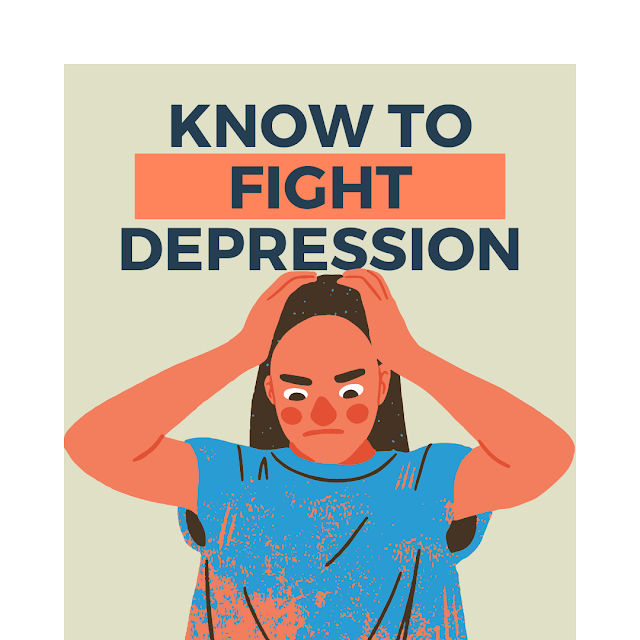Increasing depression symptoms, causes and treatment
Depression is a mood disorder that causes persistent sadness and loss of interest. Also known as major depressive disorder or clinical depression, it affects feelings, thoughts and behavior and can lead to a variety of emotional and physical problems. You may feel worthless.Not just depression, depression is not a weakness, you simply cannot "break" it. Depression may require long-term treatment. But don't be discouraged. Most people with depression feel better with medication, psychotherapy, or both.
What is depression
Depression occurs only once in a lifetime, but people usually have multiple episodes. During these episodes, symptoms he occurs most of the day, almost every day, and may include symptoms such as: , hobbies, or exercise, sleep disturbances, including insomnia or excessive sleep, Fatigue and lack of energy requiring extra effort to perform even small tasks. Decreased appetite and weight loss or increased appetite and weight gain, anxiety, agitation or restlessness, Slowed thinking, speech, or bodily movements, feelings of worthlessness or guilt, fixation on past failures, or self-blame, difficulty in thinking, concentrating, making decisions, and remembering Suicide attempt or suicide. Causes Physical problems such as unexplained back pain or headaches.
In depression, symptoms usually cause noticeable problems with daily activities such as work, school, social activities, or relationships with others as serious as Some people generally feel miserable and unhappy without knowing why.
Symptoms of Depression in Children and Adolescents
Common signs and symptoms of depression in children and adolescents are similar to those in adults, but there may be some differences.
Symptoms of depression in young children include sadness, irritability, obsession, worry, pain, school refusal and weight loss.
Adolescent symptoms include sadness, irritability, negative and worthless feelings, anger, poor grades and school attendance, misunderstandings and extreme irritability, recreational drug and alcohol use, These include overeating and sleeping, self-harm, and loss of interest in everyday life. Activity and avoidance of social interaction.
Symptoms of Depression in Older Adults
Depression is not a normal part of aging and should not be taken lightly. Unfortunately, depression in older people is often undiagnosed and untreated, and they may be reluctant to seek help.
Symptoms of depression are different in older people or less noticeable with medications
Wanting to stay home often rather than socializing or doing new things
Suicidal thoughts and feelings, especially in older men
When to see a doctor
If you are feeling depressed, see your doctor or mental health professional as soon as possible. If you hesitate to seek treatment, talk to a friend, family member, health care professional, religious leader, or someone you trust.
Causes
The exact cause of depression is not known. As with many mental disorders, a variety of factors may be involved, including Biological difference. Depressed people seem to have physical changes in their brains. The significance of these changes is still unknown, but they may ultimately help identify the cause.Brain Chemistry. Neurotransmitters are naturally occurring brain chemicals that may play a role in depression. Recent research suggests that alterations in the function and effects of these neurotransmitters, and their interaction with neural circuits that maintain mood stability, may play an important role in depression and its treatment.Changes in the body's hormonal balance may play a role in causing or triggering depression. Hormonal changes can occur during pregnancy and in the weeks or months after childbirth (postpartum). Yes, it can be caused by thyroid problems, menopause, or many other conditions. Depression is more common in people who also have relatives with the condition. Researchers are trying to find genes that may cause depression
Yogasans for depression
1. Easy Pose (Sukhasana) 2. Downward Facing Dog Pose (Adho Mukha Svanasana) 3. Upward-Facing Dog Pose (Ūrdhva Mukha Svānāsana) 4. Shoulderstand (Salamba Sarvangasana)
1. Easy Pose (Sukhasan)
Here’s how to do easy pose:
1. Sit on the floor or a yoga mat with your legs crossed. 2. Align your torso with your hips, making your spine straight and firm. 3. Lengthen your tailbone. 4. Move your shoulders back and down. 5. Rest your arms on your knees. 6.Close your eyes and take deep, relaxed breaths. 7.Focus your attention on your heart. 8.Remain here for as long as you’d like
2. Downward Facing Dog Pose (Adho Mukha Svanasana)
To do downward-facing dog pose, follow these steps:
- Come to all four on your hands and knees with a flat back.
- Lift your hips up by pushing against the ground with your toes.
- Straighten your legs and arms.
- Push against the ground with your hands to all your hips to rise up.
- Your body should come to an inverted v-shape.
- If you feel tightness in your legs, it’s OK to bend your knees.
- After taking a few breaths here, gently release the pose.
3. To do upward facing dog pose:
- Lie flat on your stomach on your yoga mat.
- Keep the balls of your feet facing upward, with your toes pointing down.
- Place your palms facing down on the mat near your shoulder blades.
- Push into your palms to elevate your upper body, smoothly curving the spine.
- Lift your chest and head while keeping your shoulders back.
- Lengthen your body from head to toe.
- Take a few deep breaths here before gently releasing the posture.
4. Shoulderstand (Salamba Sarvangasana)
1. Bend your knees, raising your legs towards your chest. 2. Press your hands into the floor to raise your bent legs over your head. 3. Move your hands onto your back to support yourself as you move your hips farther towards your head, straighten your legs as you do so. 4. Keep pressing your palms into your back; feel your body long and straight. 5. Take several relaxing breaths here before gently releasing the pose.



.png)
Comments
Post a Comment